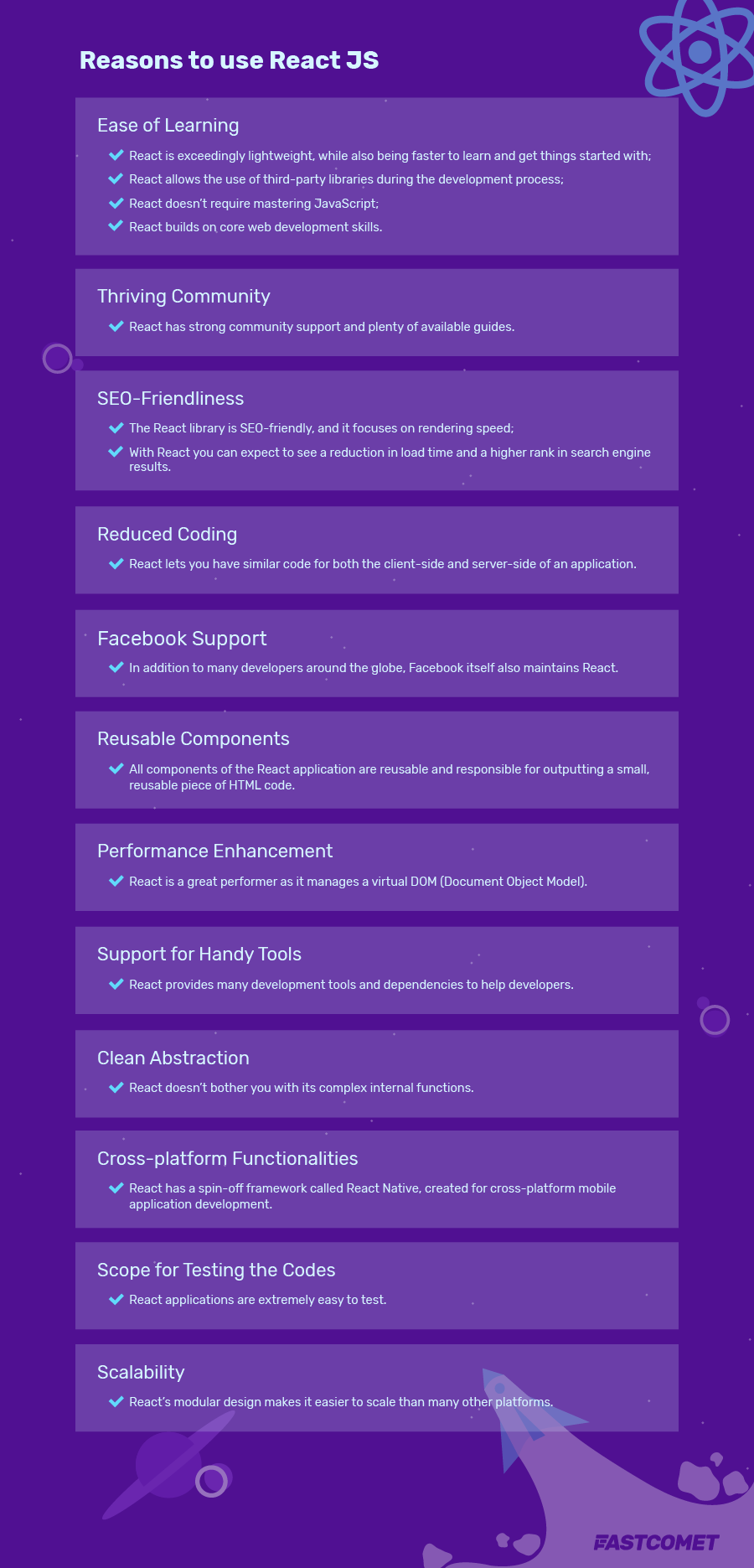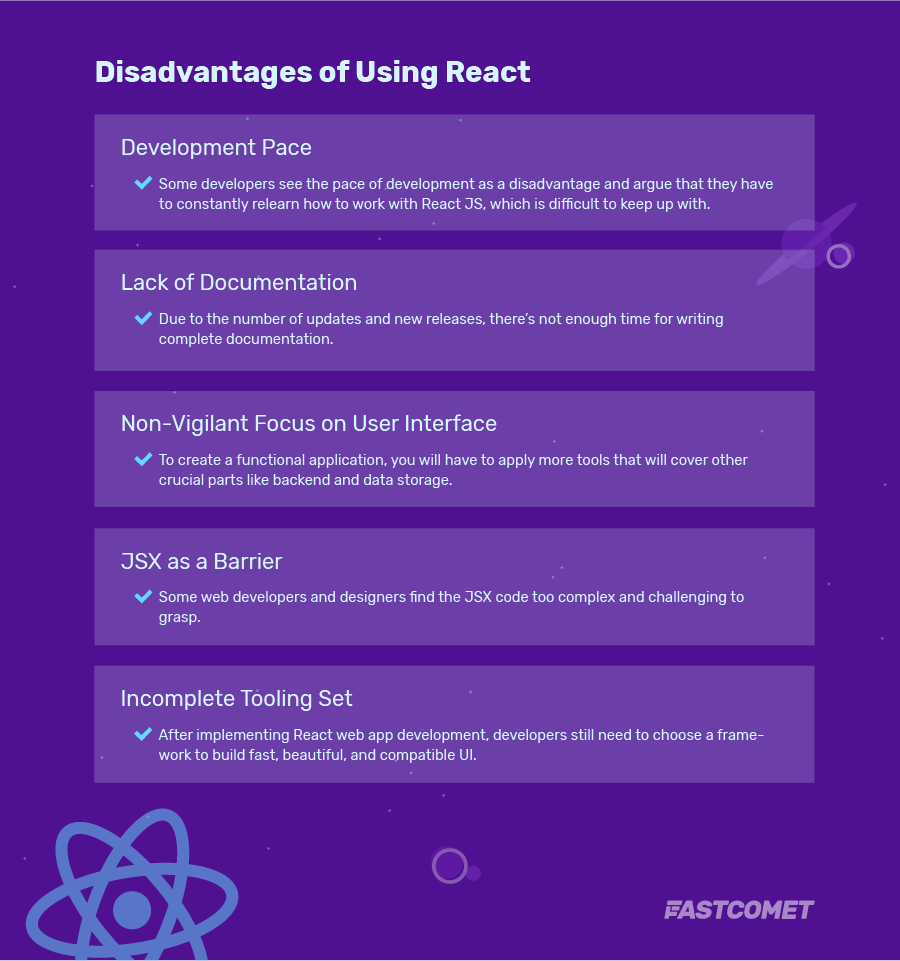
What Are The Advantages and Disadvantages of React JS
React JS seems to be everywhere. Companies and projects large and small are using it to build their applications. According to the 2021 State of Developer Ecosystem Survey, 49% of developers around the world use React. Likewise, Facebook possesses one of the largest active user bases globally, boosted by the fact that the company used React for the social network’s mobile app.
However, while React has plenty of advantages, there are some drawbacks to take into account. When starting with React, it looks very comfortable to ease into. You can immediately start a project with React. That said, this doesn’t promise that things won’t get more complicated in the future. Furthermore, you need to have knowledge and experience working with other JavaScript frameworks and tools if you want to harness React’s full potential.
Let’s look at React’s advantages and disadvantages in more detail.
Table of Contents:
What is React?
There are many JavaScript MVC frameworks to choose from. However, React is not an MVC framework. React is an open source JavaScript library developed by a team from Facebook. It’s a library for building composable user interfaces. It encourages the creation of reusable UI components which present data that changes over time. Most front-end JavaScript developers pair it with frameworks like Angular and Vue to create complex functions.
React does not use templates. Traditionally, web application UIs are built using templates or HTML directives. These templates typically dictate the full set of abstractions that you are allowed to use to build your UI. React’s approach to building user interfaces is different—it breaks them into components.
React can handle web and mobile apps’ view layers, and thus it supports web and mobile app development. This flexible framework also makes it possible to create complex apps if you utilize it alongside other supporting libraries.
React has one-way data binding, which means its structure flows from parent to child. However, for two-way data binding, React offers LinkedStateMixin, which sets up the general data flow loop pattern.
React updates are as simple as possible. In the traditional data flow, for every new data input, one had to reload the whole page to view the changes. In React, a reload is not necessary. The reason for that is that React doesn’t create any extra Document Object Models (DOM) as traditional data flows would do when accepting new updates to data.
Why You Should Use React JS

React is exceedingly lightweight, while also being faster to learn and get things started with. Additionally, React allows the use of third-party libraries during the development process. The JavaScript library also sports a bidirectional data binding process.
Let’s go over some of the crucial advantages of using React.
Ease of Learning
React’s ease of learning is truly one of its core advantages. The library is comparatively easy to learn and implement, so businesses can get a jumpstart quickly. React doesn’t require mastering JavaScript. If you already have intermediate-level experience with the language, you will be more than fine. React also natively includes features like dependency injection, which reduces the learning time for newbies.
React builds on core web development skills. That doesn’t mean that you will learn it in a day or that each of its features is easy to understand on the first try. Instead, React excels precisely because it minimizes the amount of React-specific knowledge you need for those with a basic knowledge of JavaScript and HTML.
Thriving Community
React definitely has strong community support, which can be attributed to its open source nature. Whether you face a problem, a bug, or anything else, you can be sure the community will always be there to provide you with any help they can.
Not only that, there are a ton of YouTube videos, tutorials, how-to’s, articles, React-centric web development blogs, and other publications that are available to everyone for free!
SEO-Friendliness
The React library is SEO-friendly, and it focuses on rendering speed. JavaScript-based websites can get into some trouble because of DOM re-rendering. Long loading time may also be the cause of problems with the website itself. Thanks to the virtual DOM and server-side rendering, this is no longer an issue since Google or any other search engine doesn’t have to use JavaScript directly for content rendering.
Companies that use React can typically expect to see a reduction in load time and a higher rank in search engine results as Google seems to index React-based applications quite well.
Reduced Coding
In React, you can have similar code for both the client-side and server-side of an application. That’s why any website with React has high-speed advantages, making it attractive to crawlers, users, and developers alike.
Furthermore, it’s easy to test because React can treat views as functions of a specific state.
Facebook Support
Facebook itself is a tremendous advantage of React. Not only a group of individual developers, particular communities, but Facebook itself also maintains this framework.
Facebook feels optimistic about React. Because of its great accessibility and usage, React has a wider range of possibilities for new developers to learn this framework quickly and take that first successful step toward app development.
Reusable Components
Reusable components are among the factors that influence React’s popularity. It’s safe to assume that they’re one of the essential features of React when it comes to web app development. Not to mention they speed up the entire development process.
All components of the React application are reusable and responsible for outputting a small, reusable piece of HTML code. Being the heart of all React applications, its components can also be nested. This nesting with other components allows you to create complex applications while using simple building blocks.
Performance Enhancement
React is a great performer as it manages a virtual DOM (Document Object Model). Thanks to it, developers can create fast applications that are up to modern standards.
DOM is a tree structure of XML, HTML, or XHTML documents. In other words – it’s a virtual representation of the document object model. Every time you make inputs or queries, Real DOM has to rewrite the entirety of the page, which can hamper performance and waste memory.
The virtual DOM is much more efficient and performs faster while creating a better User Interface. The virtual DOM copies the existing DOM and maintains the cache memory, saving you the effort of re-rendering the DOM trees, again and again, each time you update the HTML code. In other words, if you change any state of a component, the Virtual DOM only changes that particular object in the real DOM. This leads to smoother and faster performance.
Support for Handy Tools
React provides many development tools and dependencies to help developers. Among them are React Developer Tools and Redux Developer Tools, which are browser extensions available for both Google Chrome and Mozilla Firefox. Those tools detect errors in the code and fix bugs. They don’t require any additional skills: just install them and start by clicking a button.
Clean Abstraction
React doesn’t bother you with its complex internal functions. Internal processes like Digest cycles are not mandatory for the users to learn and understand. As a result, React delivers clear architecture such as Flux instead of architectures like MVC/MVVM.
Flux helps with building well-structured and easy-to-understand data layers in React-powered apps. Its main benefit lies in scalability — as the app extends and gets more complex, the order described above remains stable and never breaks, thus minimizing errors in the data flow and facilitating bug-fixing.
Cross-platform Functionalities
Another surprising outcome of React is the spin-off framework called React Native, created for cross-platform mobile application development. In addition, it uses React JS for dedicated mobile application development. One of its most astonishing benefits is that with React Native, you write one code for both platforms, iOS and Android.
High-compatibility
React is created to work seamlessly with other JS libraries and does not limit the possibility of using additional tools for website creation. It allows you to choose any suitable React extension that, with the help of outside controllers, will define the view layer of the page. Sometimes it’s enough to work with React on simple pages. However, the more complex the page, the more libraries it requires for proper functioning.
Coupling React with third-party libraries makes building websites a breeze. Additionally, React works great with any back-end tech stack you need. It’s easy to build and deploy the necessary UI independent of server-side tools, so you can gradually integrate the interface during the back-end development.
Scope for Testing the Codes
React applications are extremely easy to test. It offers a scope where the developer can test and debug their codes with the help of native tools. Jest is well known for testing React apps. Enzyme is another testing utility designed to help React developers check their code.
React code is stable because it has a downward data flow. Any change in the child components never affects its mother components. This helps the developers to debug with ease.
Scalability
React’s modular design makes it easier to scale than many other platforms. Simply adding components, replacing old ones with more robust versions, and making application changes piecemeal rather than wholesale makes ramping up an application to meet demands and improvements more straightforward and safer too.
Scaling up from a rapidly prototyped MVP into a full-scale production application is possible due to the feature set and design.
React JS Disadvantages

Even though React has plenty of advantages, there are some drawbacks to take into account. The most prominent of them include the pace of development, poor documentation, and UI specialization.
Development Pace
React JS is constantly evolving and changing. The pace at which React is developed can be seen as an advantage or a disadvantage depending on who you are. The developers who see these ongoing changes as an advantage would argue that React is constantly being improved and making their jobs easier. The developers who see the pace of development as a disadvantage would argue that they have to constantly relearn how to work with React JS, which is difficult to keep up with.
It should be noted, though, that React’s core API has gotten a lot more stable in recent years. Most updates today affect the library and new features.
Lack of Documentation
This drawback is tied to people’s concern with the pace of React’s development. As a result of rapid development, educational documentation and resources can be sparse in covering the latest updates and changes. Due to the number of updates and new releases, there’s simply not enough time for writing complete documentation.
Since ReactJS is an open source framework, developers are able to create their own support documents, but since anyone can create these resources, you could come across poor resources that offer little help.
Non-Vigilant Focus on User Interface
React contains a myriad of tools used to develop and create user interfaces. However, unlike frameworks, React JS is not an ‘all-in-one-tool’ for app development. Therefore, if you happen to use a model-view-controller (MVC), React development is only responsible for the UI. The developers have to create the model and controller part by using other tools. To create a functional application, you will have to apply more tools that will cover other crucial parts like backend and data storage.
You will need additional tools for app programming interfaces (APIs), routing, and other parts as well.
JSX as a Barrier
In simple terms, JSX is a JavaScript extension that can make the code more readable and clean. While the JSX syntax extension makes things easier for some developers, other web developers and designers find the JSX code too complex and challenging to grasp. JSX doesn’t negatively impact the performance or User Interface capabilities of ReactJS. This con is more of a preference than anything else.
Incomplete Tooling Set
Businesses should understand that the horizon of React only covers the UI layer of the application. Other than this, everything related to the web development project is out of its periphery. Thus, even after implementing React web app development, the developers still need to choose a framework to build fast, beautiful, and compatible UI. Since the entire tooling set is not available only with React, the developers will face difficulties completing the project.
Here are some of the React-based frameworks used by developers:
- Material UI;
- Ant Design;
- Redux;
- React Bootstrap;
- Atomize.
React on FastComet
Making your React app public requires a hosting server to deploy it on. Like launching a website, you can do so by purchasing a hosting plan.
If you’re going to build modern interfaces with React, you would definitely need a modern React JS Hosting provider.
To React or Not to React?
Understanding the pros and cons of React is vital when choosing a JavaScript framework. The reasons that React climbed to become as highly popular as it has are plentiful and strong at the same time. React JS’s most significant drawbacks are due to human preferences. In terms of performance and output, there are no major disadvantages to using React versus another JavaScript framework.

The latest tips and news from the industry straight to your inbox!
Join 30,000+ subscribers for exclusive access to our monthly newsletter with insider cloud, hosting and WordPress tips!



No Comments